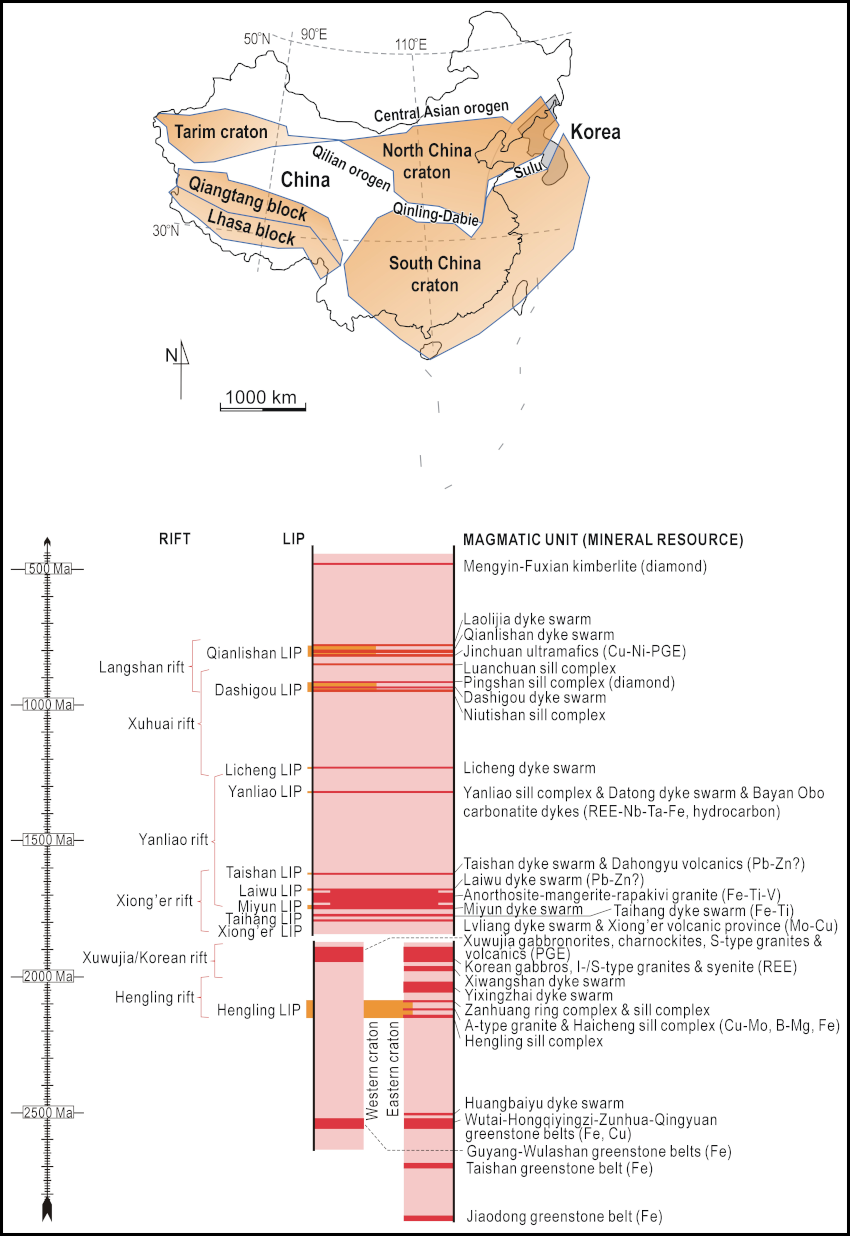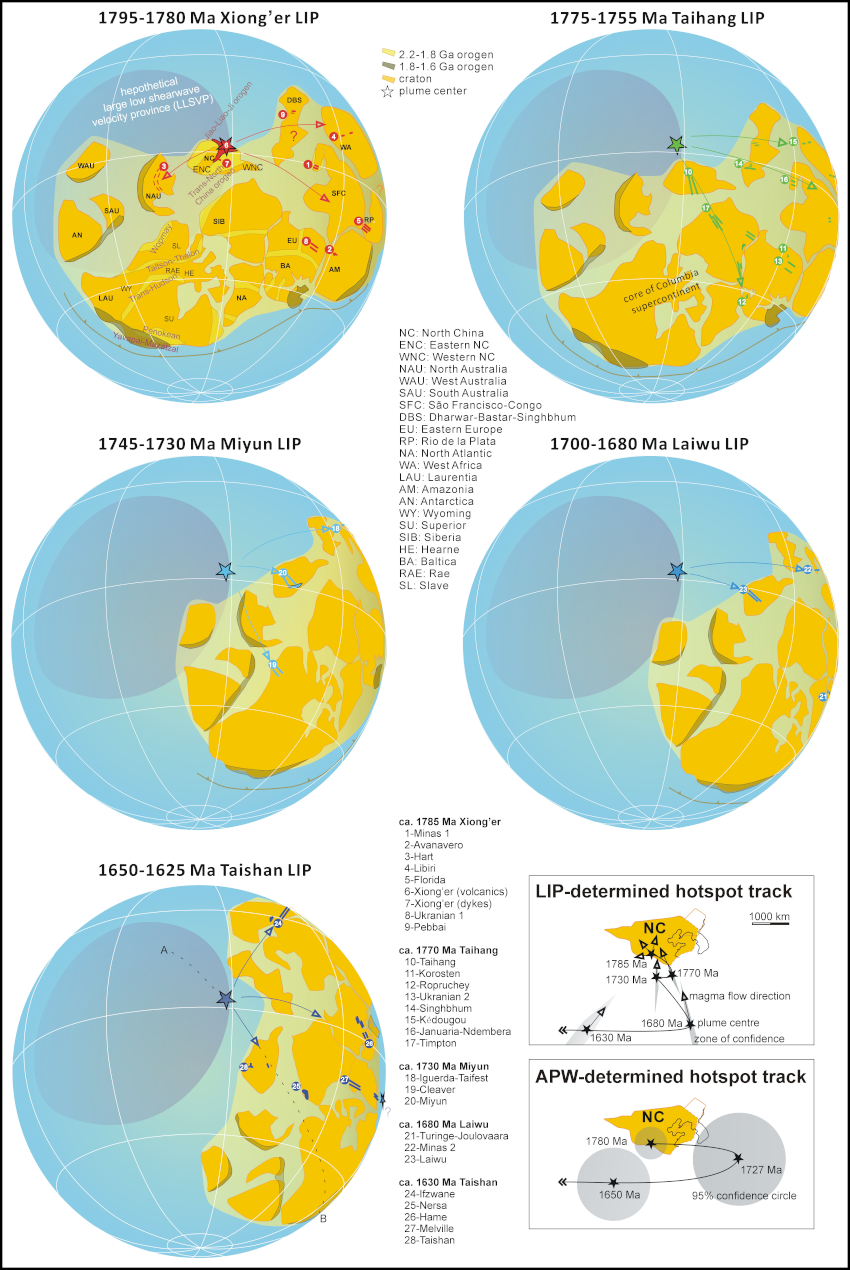June 2022 LIP of the Month
Major global 1800-1600 Ma large igneous provinces were from one single pulsed-plume?
Peng Peng1,2
1 Institute of Geology and Geophysics, Chinese Academy of Sciences, Beijing, China
2 University of Chinese Academy of Sciences, Beijing, China
Extracted from:
Peng, P., Xu, H., Mitchell, R.N., Teixeira, W., Kirscher, U., Qin, Z., Oliveira, E.P., Girardi, V.A.V., Wang, C. and Chemale, F., 2022. Earth's oldest hotspot track at ca. 1.8 Ga advected by a global subduction system. Earth and Planetary Science Letters, 585: 117530. https://doi.org/10.1016/j.epsl.2022.117530
Peng, P., Xu, H., Wang, C., Su, X., Sun, F. and Wang, X., 2022. Spatiotemporal evolution of large igneous provinces and their related rifts in North China craton: Role in craton breakup and destruction. Geological Society, London, Special Publications 518, SP518-2021-2045. http://dx.doi.org/10.1144/SP518-2021-45
Reading guidelines:
The 1800-1600 Ma igneous units in the North China craton (NCC) have been recognized as associated with five large igneous provinces (LIPs), i.e., the ca. 1785 Ma Xiong’er (a volcanic province and a circumferential dyke swarm), the ca. 1770 Ma Taihang (a giant dyke swarm), the ca. 1730 Ma Miyun (a dyke swarm of two major subswarms), the ca. 1680 Ma Laiwu (a dyke swarm, a few rapakivi granitic plutons and anorthosite-mangerite complexes), the ca. 1630 Ma Taihang (a dyke swarm with two sub-swarms and a volcanic formation) (Peng et al., 2022a: Figures 1) (see also June 2005, September 2014, and April 2009 LIP of the Month: http://www.largeigneousprovinces.org/05jun [by Franco Pirajno & Yanjing Chen]; http://www.largeigneousprovinces.org/09apr [by Peng Peng]; and http://www.largeigneousprovinces.org/14sep [by Peng Peng]). These five episodes of LIPs are compared with the global record of over twenty contemporaneous units from more than ten cratons including Amazonia, Baltic - Eastern Europe, Dharwar – Bastar - Singhbhum/India, North Atlantic, North Australia, Rio de la Plata/South America, São Francisco/Brazil, Siberia, Slave/Laurentia, and West Africa (Peng et al., 2022b: Figure 2). They were grouped in five episodes with lifespans of <20 Myr for each and intervals of ~20 Myr between each, i.e., 1795-1780 Ma, 1775-1755 Ma, 1745-1730 Ma, 1700-1680 Ma, and 1650-1625 Ma (Peng et al., 2022b). The available whole-rock chemical data of the five generations of LIPs show very good consistency within each episode, supporting them to be unified LIPs prior to continental breakup (Peng et al., 2022b). These five LIPs mostly show bimodal compositions, with a systematic variation of compositions through time, the 1795–1755 Ma LIP units exhibit a lithospheric mantle affinity (e.g., depleted high-field strength elements), the 1745–1730 Ma generation LIP units are similar to oceanic island basalts, and the 1700–1625 Ma LIP units show a mixing of continental crustal melts and oceanic island basaltic sources, based on a whole-rock chemistry and Nd-Sr-Pb isotopes, and in general, they show a trend of increasing juvenile/plume source contributions (Peng et al., 2022b).
Giant radiating dike swarms are thought to be fed by magma centers with a convergence point of each swarm approximately matching its magma center (Ernst et al., 2019). Most of these 28 LIP units (Figure 2) were distributed in paleo-geographically neighboring cratons based on previous reconstructions (e.g., Kirscher et al., 2021). For example, the ca. 1785 Ma Xiong’er LIP is well-recognized to be sitting in a triple-junction rift with a magma center in the center of the rift based on anisotropy magnetic susceptibility (AMS) study (Xu et al., 2020). The twenty-eight igneous units, especially the dike swarms of the five LIPs, were plotted on a updated global paleogeographic reconstruction based on a paleomagnetic dataset, which roughly point to a single magma region, referred as the Xiong’er plume (Peng et al., 2022b: Figure 2). However, the magma centers of the five generations of LIPs deduced from the global paleomagnetic dataset (apparent pole wonder, APW) do differ slightly in position and represent a hotspot track on the supercontinent, which is more or less consistent with what deduced from the geometry and magma flow directions of dike swarms of the LIPs in the North China craton alone (Figure 2). This increases the validation of connecting most global LIP units between 1795-1625 Ma as being from the same plume center. If this reconstruction is verified, it comprises a series of giant dyke swarms with a scale of over 2000 km (Figure 2), even slightly larger than the scale of the Mackenzie giant dyke swarm (Ernst et al., 2016) (see also September 2008 LIP of the Month: http://www.largeigneousprovinces.org/08sep [by James M.D. Day]). It is apparent that the major mantle upwelling of the Xiong’er plume on one edge and circum-Columbia supercontinent subduction girdle on the other edge formed a global plume-subduction network, which resulted in the assembly of the supercontinent (Peng et al., 2022b: Figure 2). The apparent diminishing of the Xiong’er plume at ca. 1625 Ma may reflect the settling of aggregating continents in the topographic low away from the mantle upwelling during the final amalgamation of Columbia (Peng et al., 2022b). This is similar to the situation of present-day Australia, which produced a series of LIPs along a hotspot track across the continent (Davies et al., 2015) on its way northward to the growing Eurasia in the ongoing supercontinent cycle (Mitchell et al., 2012; Wang et al., 2021).
Acknowledgment: Richard E Ernst is thanked for inviting this report and for editing the draft. Financial support of the study comes from the Chinese Academy of Sciences (CAS) and National Natural Science Foundation of China (NSFC).

Fig. 1 Geological barcode of large igneous provinces in the North China craton. Revised from Peng et al. (2022a).

Fig. 2 The global 1795-1625 Ma large igneous provinces restored to a same plume center, the Xiong’er plume, across a paleogeographic reconstruction of the Columbia supercontient. After Peng et al. (2022b).
References
Davies, D.R., Rawlinson, N., Iaffaldano, G. and Campbell, I.H., 2015. Lithospheric controls on magma composition along Earth's longest continental hotspot track. Nature, 525(7570): 511-4.
Ernst, R.E., Hamilton, M.A., Söderlund, U., Hanes, J.A., Gladkochub, D.P., Okrugin, A.V., Kolotilina, T., Mekhonoshin, A.S., Bleeker, W., LeCheminant, A.N., Buchan, K.L., Chamberlain, K.R. and Didenko, A.N., 2016. Long-lived connection between southern Siberia and northern Laurentia in the Proterozoic. Nature Geoscience, 9: 464-469.
Ernst, R.E., Liikane, D.A., Jowitt, S.M., Buchan, K.L. and Blanchard, J.A., 2019. A new plumbing system framework for mantle plume-related continental Large Igneous Provinces and their mafic-ultramafic intrusions. Journal of Volcanology and Geothermal Research, 384: 75-84.
Kirscher, U., Mitchell, R.N., Liu, Y., Nordsvan, A.R., Cox, G.M., Pisarevsky, S.A., Wang, C., Wu, L., Murphy, J.B. and Li, Z.X., 2021. Paleomagnetic constraints on the duration of the Australia-Laurentia connection in the core of the Nuna supercontinent. Geology, 49(2): 174-179.
Mitchell, R.N., Kilian, T.M. and Evans, D.A., 2012. Supercontinent cycles and the calculation of absolute palaeolongitude in deep time. Nature, 482(7384): 208-11.
Peng, P., Xu, H., Wang, C., Su, X., Sun, F. and Wang, X., 2022a. Spatiotemporal evolution of large igneous provinces and their related rifts in North China craton: Role in craton breakup and destruction. Geological Society, London, Special Publications 518, SP518-2021-2045.
Peng, P., Xu, H., Mitchell, R.N., Teixeira, W., Kirscher, U., Qin, Z., Oliveira, E.P., Girardi, V.A.V., Wang, C. and Chemale, F., 2022b. Earth's oldest hotspot track at ca. 1.8 Ga advected by a global subduction system. Earth and Planetary Science Letters, 585: 117530. https://doi.org/10.1016/j.epsl.2022.117530
Wang, C., Mitchell, R.N., Murphy, J.B., Peng, P. and Spencer, C.J., 2020. The role of megacontinents in the supercontinent cycle. Geology, 49(4): 402-406.
Xu, H., Yang, T., Dekkers, M.J., Peng, P., Li, S., Deng, C. and Zhu, R., 2020. Magma flow pattern of the 1.78 Ga dyke swarm of the North China Craton during the initial assembly of the Supercontinent Nuna/Columbia: Constraints from rock magnetic and anisotropy of magnetic susceptibility studies. Precambrian Research, 345: 105773.
